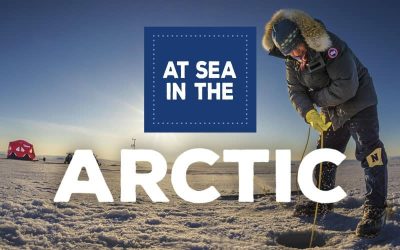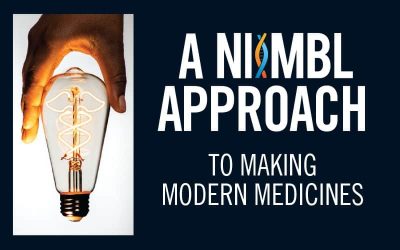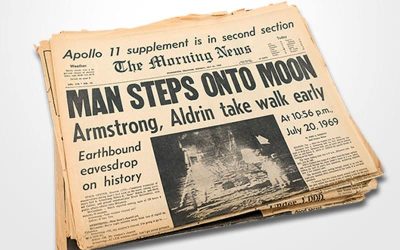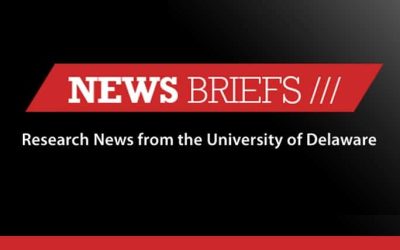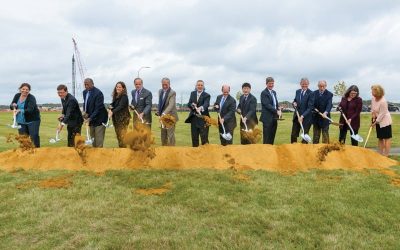


by Beth Miller | March 24, 2018
As soon as Neil Armstrong took that one small step and put his size-9 1/2 foot on the surface of the moon in 1969, people started asking: When will the first Marswalk be?
If reaching the moon was a “giant leap,” as Armstrong said it was, getting to Mars is at least two orders of magnitude beyond. You could look at it this way: If you were the world’s best “giant leap” guy—world record holder Mike Powell, say—you’d have to go from jumping 29 feet, 4 1/2 inches (just short of a first down) to jumping 5 1/2 miles (more than 96 football fields).

“The level of precision, the modeling, the manufacturing—that could only be done with the full capabilities of the center, the right people with the right skills.”
—Jack Gillespie, Center for Composite Materials Director
Getting to Mars is an enormous challenge—and survival after arrival? No human being can survive real-life conditions on Mars without extraordinary protection and support.
So before anyone starts packing for such a trip, an essential question must be resolved: What do you wear on Mars?
ILC Dover should know. The Delaware firm has been outfitting NASA astronauts—including Armstrong—since the Apollo Mission. And when this contract to build the next generation Z-2 spacesuit arrived from NASA, ILC tapped into the state-of-the-art technology, science and mathematics available at the University of Delaware’s Center for Composite Materials (CCM).
 There, they have access to the expertise of professors, researchers, a team with extensive experience in aerospace, industry and manufacturing and a facility that meets NASA’s security requirements. ILC has worked with UD on NASA’s EPSCoR program—Established Program to Stimulate Competitive Research—and is part of the new NIIMBL team, a UD-led, national manufacturing institute focused on improving access to safe and effective biopharmaceuticals.
There, they have access to the expertise of professors, researchers, a team with extensive experience in aerospace, industry and manufacturing and a facility that meets NASA’s security requirements. ILC has worked with UD on NASA’s EPSCoR program—Established Program to Stimulate Competitive Research—and is part of the new NIIMBL team, a UD-led, national manufacturing institute focused on improving access to safe and effective biopharmaceuticals.
“We were very impressed with UD’s CCM lab and the fact that you’ve got University personnel who have strong industrial and manufacturing experience,” said Stephen Scarborough, ILC Dover’s research and development engineering manager who earned his bachelor’s degree in environmental engineering (1999) and master’s in materials science and engineering (2007) at UD. “You have this combination of professors and researchers who are able to perform amazing analysis with impact and composite properties—modeling and manufacturing and material selection all at one facility.”
CCM—with its broad range of capacity and decades of experience—was indeed a good match.
“The level of precision, the modeling, the manufacturing—that could only be done with the full capabilities of the center, the right people with the right skills,” said Jack Gillespie, director of CCM since 1996 and the architect of a university-industry consortium that now includes more than 50 partners.
Several Z-2-related NASA projects have gone to new small businesses with ties to CCM (as the story on p. 26 explains) to address new technology improvements identified by CCM. And CCM’s contributions to the Z-2 suit will continue—new designs, new processes and new composite materials—as it remains a source of new technology for those businesses.
On Mars, the suit must protect the astronaut from radiation, sharply reduced atmospheric pressure, extreme temperature changes, falls, micrometeoroids, dust storms and other planetary perils.
And it’s not all about OSHA-like requirements. There is much work to do. So the Z-2—meant to be worn outside the spacecraft—had to be ultralight and designed in ways that wouldn’t bog down or restrict the movement of the human wearing it.
NASA’s requirements for this training suit were rigorous. The Z-2 suit had to meet approximately 200 flight-like requirements, including increased mobility, increased strength and increased impact resistance and a nominal operating pressure of 8.3 pounds psid (per square inch differential). Today’s spacesuits are rated at 4.3 psid, which requires astronauts to “pre-breathe” oxygen before getting into the suit to remove the nitrogen from their blood and prevent decompression sickness. The Z-2’s pressurization level does not require that extra step.
Following NASA specifications and using new computer models and simulations developed at UD, CCM and its south-of-campus Applications and Technology Transfer Lab (ATTL) delivered new components for ILC Dover that make the Z-2 suitable for landings on the moon and Mars.
That’s something like taking just one outfit on a vacation that goes from a lake of burning sulfur to a cryogenics lab. You don’t get clothes like that off the rack.
That’s why NASA chose ILC Dover to develop these suits. The world’s leading space agency was confident ILC could deliver what was needed because it has done that many times in the past. ILC recruited UD researchers to help solve several materials problems and expedite development to meet NASA’s ambitious deadlines.
“That is a great computational challenge,” Haque said.
Defending the astronaut against micrometeoroids that might arrive at speeds greater than 2,237 miles an hour was another high-level problem to address.
Using state-of-the-art MAT162 software, Haque was able to calculate and show the kind of damage that would occur in a range of scenarios, and the team came up with a composite material and a process that would perform in every situation.
“What he developed for the Z-2 that is unprecedented in suits is a damage-tolerance model, an impact model,” said David Graziosi, ILC’s principal engineer. “It was important to NASA to develop impact requirements relevant to the moon and Mars. We looked at both gravity fields, and nothing was well-defined in the past. We did a little with previous suits, but nothing in the way of mathematical modeling.”
With Haque’s precise analysis, ILC, UD and NASA chose a hybrid structure of carbon and glass in a matrix of epoxy that Graziosi calls “the most advanced composite structure ever deployed in space” for the Z-2’s Hard Upper Torso (HUT). The HUT is a fiberglass-strengthened shell that protects the body and also bears the weight of a life-support system, communication devices and attachments for tethers and assorted connections.
CCM crafted the suit’s brief, HUT and the disk-like entry hatch that mounts to the back of the torso and attaches to a portable life support system. The astronaut enters the suit through that hatch, which is then closed off after the astronaut is in the suit. This method makes it easier to get into and out of the suit and provides a better fit for astronauts.
The tailors of many critical Z-2 components work at CCM’s ATTL site—a nondescript, warehouse-like building about four miles south of UD’s main campus. The work space has several partitioned areas including an engineering center and a fabrication area, where a huge American flag, maybe 20 feet by 15 feet, hangs from the ceiling.
“We’re in America and we work on a lot of military projects for our country,” said Rennie Burris, research technician, who worked on aeronautics and military applications with General Electric before joining the CCM team nine years ago.
A vertical milling center is onsite. The team contracted out some of the work and used the autoclave at Aberdeen Proving Ground in Maryland.
 Jason Etherington (left) and Dan Molligan worked with composite materials to customize items needed for the Z-2 spacesuit. With many ways to tweak the materials’ properties, “your engineering toolbox becomes almost infinite,” Molligan said.
Jason Etherington (left) and Dan Molligan worked with composite materials to customize items needed for the Z-2 spacesuit. With many ways to tweak the materials’ properties, “your engineering toolbox becomes almost infinite,” Molligan said.The project unfolded over a three-year period, as ILC and UD experts explored material options, worked on designs, determined necessary stiffness and tensile strength of materials, tested the load they could bear and the strain they could withstand, figured out how they should fit together and how they would react to sometimes-extreme changes in temperature and pressure. They designed tools and processes to produce what was needed.
They met with many challenges, as you might expect.
For example, wrapping a flat fabric around a cylinder is not usually a problem, Molligan said. Wrapping it around a sphere requires shearing —a definite complication.
There are no flat spaces on the torso piece, he said, and that makes it more difficult to lay out the materials, especially in areas where the carbon fiber epoxy material goes from thin to thick. The thickness can range from an eighth of an inch to 2 inches in some places. Thicker materials are required to accommodate attachments and connective pieces, and there were about 500 such attachments in the upper torso of the Z-2 design.
Molligan brings the kind of experience Scarborough says is greatly valued in such projects. He has worked in the wind energy field, computer design and spent 10 years with the DuPont Co.
Now working with composite materials, Molligan said he and other designers can customize fabrics to the need—whether the need is for greater strength, lighter weight, more flexibility, all of the above or any number of other requirements.
“Your engineering toolbox becomes almost infinite,” Molligan said.
The material in the Z-2—carbon fiber with 1 million pounds per square inch of tensile strength—is impregnated with resin and cut to precise specifications using a computer-controlled ply cutter. A large quantity of this material was needed and Patz Materials and Technologies of Benicia, California, was able to deliver it quickly.
The pieces are then positioned using a laser system that projects the patterns—hundreds of unique patterns were involved—onto the Z-2 part tool. A layer of S-glass is incorporated to increase impact resistance. And thousands of these custom pieces, each about 12 thousandths of an inch thick, are layered onto each other, debulked to 7 or 8 thousandths of an inch, then layered again in the pattern specified for each piece of the components.
“It was one of the most technically challenging projects I have ever worked on,” said Etherington, who has worked with CCM for 15 years.
“And by far, one of my favorites,” Burris said.
The Z-2 was subjected to months of rigorous testing at NASA’s Neutral Buoyancy Lab near the Johnson Space Center in Houston. There, astronauts were submerged in a giant tank filled with a million gallons of water, in which they practiced the maneuvers they will perform in space and put the suit through its paces.
In that chlorinated environment with elevated temperatures, there were questions about whether galvanic corrosion would occur, especially where the composite materials met with metal parts, Graziosi said. But no problems have emerged with that, he said.
Testing continued into last summer, and as materials and designs are evaluated, NASA will make decisions about the next step for the Mars spacesuit.
More questions and new challenges will arise, more traction will be gained.
“Sending a human to Mars will answer some of the major questions that humanity has,” Scarborough said. “Is there life there? Is life on our planet the only place in the universe or the solar system where it exists? And being able to put a human there instead of a robot allows the research to happen so much faster.”
As with so many NASA-led developments, the technological advances and innovations that are part of this mission are likely to have applications in many other areas.
“The idea of hybrid carbon-glass composites can have application in high-performance vehicles,” Scarborough said, “potentially with impact resistance and military-type impact performance. Some things developed for the military are now being qualified to be used in space.”
The fast pace needed to meet NASA’s deadlines was challenging for all, “but we are very happy with the work,” Scarborough said.
And the Z-2 has performed well.“There have been no issues with the suit and nothing with the composite structure, which is really good on a prototype like this,” Graziosi said. “They’re hanging simple things—mockup life support systems—but those are a lot of stressing interfaces to the hatch and the HUT, while the crew goes into the water to do things.
“They have had zero issues, zero leakage, zero structural problems. And that’s a really big deal.”
About the Center for Composite Materials
CCM has been designated a Center of Excellence by the National Science Foundation, the Department of Defense and the Federal Aviation Administration for more than 30 years.
The center dates to 1974, when its team focused on design, mechanics and structural components, according to Prof. Jack Gillespie, who has been with CCM since 1981. It evolved into processing, microstructures and performance of components and in the 1980s expanded its interdisciplinary approach, he said. Now, modeling and simulation are essential features of the work, sharply reducing the time and resources once spent in trial and error.
With more than 50 industry partners and strong collaborations with government agencies, CCM offers a wide range of research opportunities for undergraduate and graduate students, as well as faculty and professional staff. Its work has a broad reach, too, ranging from what is known as Technology Ready Level 1 (TRL-1)—basic research—to TRL-9, products/processes ready for commercialization and scaling up.
“Is there life there? Is life on our planet the only place in the universe or the solar system where it exists? And being able to put a human there instead of a robot allows the research to happen so much faster.”
—Scarborough
Re-enactors of medieval yore might still find such items appealing. But in this day of space travel and futuristic composite materials, chemists and engineers and other visionaries are coming up with all sorts of custom recipes to produce lightweight textiles with just the right mix of strength, flexibility, ballistic resistance or whatever else a substance must be able to deliver.
The first astronaut to step onto Mars will be protected from the many perils of that harsh environment and be able to walk about and do real work. ILC Dover, which has outfitted astronauts since the Apollo Mission, will see to that with help from partners in the University of Delaware’s Center for Composite Materials.
CCM’s team has a strong track record of producing materials and processes to fit today’s most demanding projects, and a growing cadre of collaborators are always coming up with new challenges to tackle. It has spun off new companies and is helping small businesses generate money for growth and job creation in Delaware, according to Jack Gillespie, director since 1996.
Several new NASA grants have emerged through CCM’s partnership with ILC Dover on the Mars prototype spacesuit Z-2 as researchers and UD-linked businesses work to improve materials and performance of the suit.
Four CCM-linked businesses won funding for new NASA projects in 2016—including Composites Automation, which has two projects with primary investigators Suresh Advani, CCM associate director, and Senior Scientist Bazle “Gama” Haque; a third project led by STF Technologies, co-founded by UD professor and inventor Norm Wagner and UD alum Rich Dombrowski, with Haque as primary investigator; and one with Maher and Associates, with primary investigator Danny Molligan, CCM associate director.
Composites Automation is a new startup founded by CCM Assistant Director Dirk Heider. It already has won funding for four projects, including two with the U.S. Navy and two with NASA to improve performance of the hard composite components of the Z-2 spacesuit and development of ultra-high performance thin-ply composites for robotic placement and additive manufacturing of ultra-light space structures. Composites Automation credits the company’s recent success to its partnership with CCM.
STF Technologies is working to incorporate its shear thickening fluid in parts of the Z-2 to make the spacesuit tougher and more damage resistant. Wagner developed the shear thickening fluid technology—which turns flexible material into a hardened shield when it encounters such things as bullets or knives—in collaboration with UD alumnus Eric Wetzel of the U.S. Army Research Laboratory.

STF is in the second phase of a NASA project to produce a prototype material that improves the cut-, puncture- and impact-resistance of spacesuits used in low-Earth orbit (where the International Space Station is) or for exploration on the moon or Mars. It is also working on strengthening the hard upper torso (HUT) part of the suit by collaborating with Haque and his computational expertise.
“We have proven in previous work that we could build our materials into the composite in such a way that they can dramatically improve their ability to withstand impact,” Wagner said. “Imagine if a material is ‘smart’ enough to respond stronger when it is hit harder.”
Wagner said STF is also working with NASA to address problems related to regolith, the fine, abrasive dirt and dust that gets into everything.
And in a longer, third project STF is working on through the Delaware Space Grant Consortium, Wagner expects to send protective parts of suits for testing outside the International Space Station next fall, where they will be exposed to the hostile environment of low-Earth orbit for a year.
“I grew up in the ‘Star Trek’ generation,” Wagner said. “You always think about these things. Humans have it in our nature to want to explore new places, new worlds, oceans, skies and the solar system. It drives us to develop new technologies.
“The things we’re learning working with NASA we hope to translate back to technologies to better protect people here on planet Earth—whether they are working in hospitals or laboratories or even on their lawn, handling trash, working in industry or just need better protective materials in hazardous environments.”
Some of that brainstorming will be done through UD’s Office of Economic Innovation and Partnerships, where undergraduate students in the popular “Spin-In” program will try to develop Earth-based applications, Wagner said.
“CCM’s mission here on Earth has been to conduct basic and applied research, educate scientists and engineers and transition technology to industry,” Gillespie said. “This mission has evolved over the decades and now includes entrepreneurship, innovation and economic development.”
MORE STORIES
2017 Research in Progress
What’s it like to do research in the Arctic? What ‘s it like to be on a ship for 4 to 6 weeks off Greenland? How do you work and sleep with 24 hours of daylight? Oceanographer Andreas Muenchow gives us a glimpse into his world.
At Sea in the Arctic
What’s it like to do research in the Arctic? What ‘s it like to be on a ship for 4 to 6 weeks off Greenland? How do you work and sleep with 24 hours of daylight? Oceanographer Andreas Muenchow gives us a glimpse into his world.
The Quiet Revolution
Trevor A. Dawes learned how libraries can change people’s lives when he was a college student. Now, he’s leading the charge to make the UD Library, Museums and Press an even greater force for good.
The hidden lives within a portrait
A 1746 portrait would launch a global journey into 18th-century life and present the past in a way never done before. The portrait was of Anne Shippen Willing, and what she wore would lead historian Zara Anishanslin on a journey to the far corners of the world—and launch a bold new way of looking at the past.
Filling a Real Demand for Simulated Care
Nursing instructor Amy Cowperthwait and her students are inventing products with a common goal: teaching compassionate patient care. Cowperthwait’s startup links students, engineers, business experts on quest to teach challenging medical procedures.
A NIIMBL Approach To Making Modern Medicines
Biopharmaceuticals have emerged recently and are having a revolutionary impact on vexing diseases such as cancer. The National Institute for Innovation in Manufacturing Biopharmaceuticals (NIIMBL), headquartered at the University of Delaware, is at the forefront of making medicines more accessible to Americans.
Exploring the Red Planet
NASA wants to put humans on Mars by the early 2030s. University of Delaware researchers are helping to develop spacesuits for that mammoth expedition. Yet Mars is shrouded in mystery for many of us. So what do you know about Mars? Let’s test your knowledge.
1969 – The Morning News: Man Steps onto Moon
Astronaut Neil A. Armstrong took the first moon step at 10:56 p.m., Delaware time, just six hours and 39 minutes after he and Edwin E. Aldrin Jr. fulfilled the age-old dream of landing on the moon. This was a major milestone in the new era of space exploration. We invite you to explore this interactive experience and relive the excitement of the first moon landing.
News Briefs
Learn how UD researchers are sharpening that competitive edge, fighting brain cancer, giving credit where credit is due, partners in disaster research and UD-NUVVE collaboration
Partnerships in progress
Multiple partnerships took wing in the past year to ensure UD’s scholarly efforts have the broadest and most sustained impact. Learn about the collaborations that ensure a UD world-class educational experience while serving as a major force for economic development.
Honors
Eight UD professors recently received the National Science Foundation’s highly competitive CAREER Award, which is given to scientists and engineers who exemplify the role of teacher-scholars through their outstanding research and teaching.






